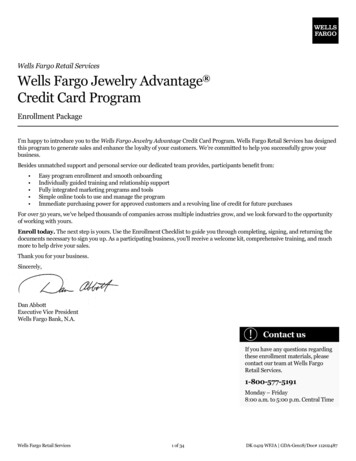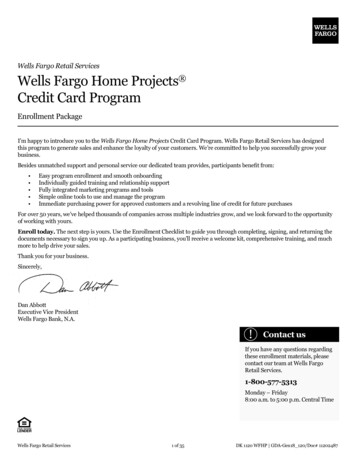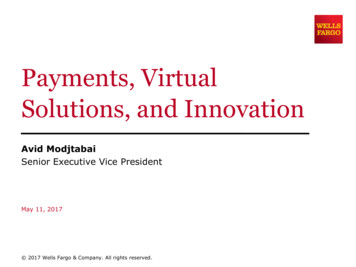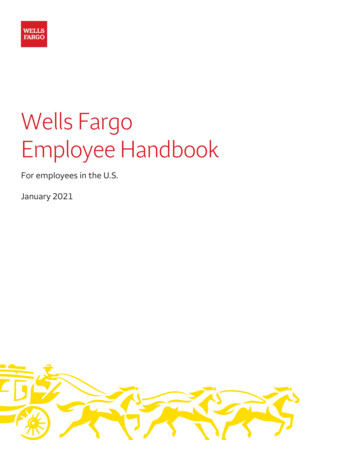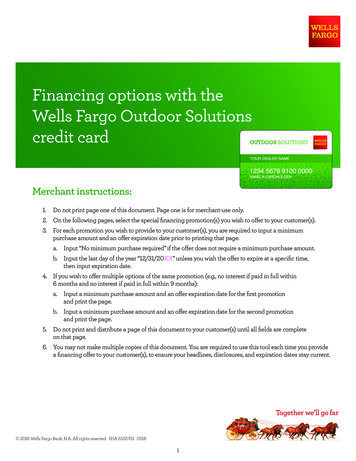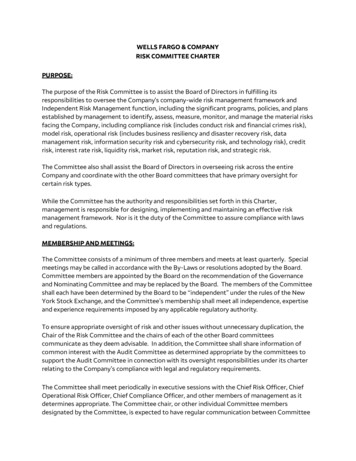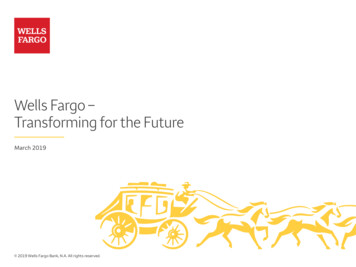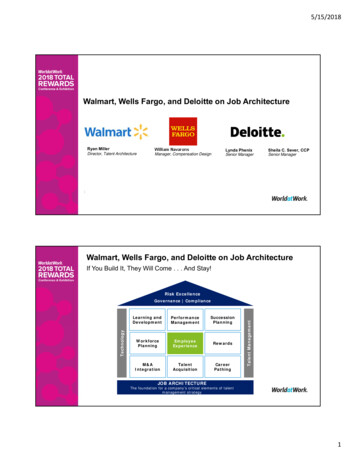
Transcription
5/15/2018Walmart, Wells Fargo, and Deloitte on Job ArchitectureRyan MillerDirector, Talent ArchitectureWilliam NavaronsManager, Compensation DesignLynda PhenixSenior ManagerSheila C. Sever, CCPSenior Manager:Walmart, Wells Fargo, and Deloitte on Job ArchitectureIf You Build It, They Will Come . . . And Stay!Risk ExcellenceLearning tegrationTalentAcquisitionCareerPathingTalent ManagementTechnologyGovernance ComplianceJOB ARCHITECTUREThe foundation for a company’s critical elements of talentmanagement strategy1
5/15/2018IntroductionsLynda PhenixSheila C. Sever, CCPSenior ManagerDeloitte Consulting LLPSenior ManagerDeloitte Consulting LLPServes as a strategic partner in a variety ofJob Architecture projects covering multipleindustry sectors with a recent focus on M&A.She has played a key role in the developmentof Deloitte Consulting’s core job architecturemethodology and tools. She was a maindriver behind Deloitte Consulting’s Global JobArchitecture Practices Survey.Sheila has 20 years of consulting and corporateexperience working with a wide range of clients.She has published on a variety of topics inWorldatWork Journal and workspan. Today’ssession marks her fifth Total Rewards conferencepresentation. She advises clients on optimizingtheir total rewards package to best attract andretain talent across their organizations.William NavaronsRyan MillerManager, Compensation DesignWells FargoDirector, Talent ArchitectureWalmartLeads the development for company-widecompensation design initiatives coveringcompensation philosophy, strategy, andprogram framework. He is currently serving in aleadership role in the planning and design of anupdated approach to job architecture. Prior tojoining Wells Fargo, he has held significantcompensation leadership roles in multipleindustry sectors as well as consulting. Williamhas published on various compensation topicswithin World at Work, the National Associationof Stock Plan Professionals (NASPP) and theNational Center for Employee Ownership(NCEO). William holds CCP, CBP, and GRPcertifications from WorldatWork.Ryan is a member of the Global People Divisionleadership team at Walmart and is currently focusedon the redesign of the organization’s talentarchitecture. In this role, he collaborates to developlearning and growth programs that are increasinglydigital in nature and in alignment with Walmart’svision of the future of work. He draws from 25 yearsof Human Resources experience, includinginternational assignments – most recently as theHead of Talent Development for Walmart for APACmarkets. He was also responsible for thedevelopment of Top Talent & Executive Developmentfor Next Generation Walmart globally.Session objectivesThe purpose of this session is to fill in the knowledge gap on job architecture practices through sharingDeloitte’s proprietary research and discussing the practical application of these findings through a paneldiscussion with industry leaders who are in the midst of job architecture projects. Today we will:1Provide pointers on how to present a case for Job Architecture to yourorganization: articulating the resulting benefits to talent management,compensation investments and employee experience2Share leading practices in job architecture design, such as design principles,number of job levels, job titling conventions, career pathing, job/role growthcriteria and governance3Discuss Job Architecture experiences at Walmart and Wells Fargo through apanel discussion with Human Capital leadership2
5/15/2018Job architecture defined and making thecaseTotal rewards and the connection to job architectureThe core componentsof job architecture—jobs and associatedpay values are oftenthe nucleus andcommon factors uponwhich human capitalprograms are built.While job architecture ismost commonly thedomain of thecompensation function,these programs serveas the foundationalelements of anorganization’s talentstrategy.While “compensationowned”, it is more thanjust about pay.Job architecture is tiedto the core elements oftotal rewards3
5/15/2018Job architecture definedAssociated with many “labels” including the job catalogue, career framework, job bank, leveling, etc.,job architecture is an umbrella that contains the following core Human Capital programs centeredaround the development, implementation and administration of both the job framework and paystructure: Identify number oforganizational levels andassignment of jobs tothose levels Create consistentcriteria for entry Assess appropriatespans of control(optional) Job groups/job families Dimensions and factors Number of levels Desired level of overlapacross ArchitectureJob TitlesJob Levels Job progressions—creatingmeaningful, cross-organizationaltitles that accurately reflect leveland work Job titles are typically associatedwith job codes to be loaded in HCMSystemGlobal JobArchitecture: Creates organizationallanguage to consistentlydefine positions globally. It isthe foundation for otherelements across HR,particularly Rewards, Talent,and work environmentPay Grades Determine linkages to paygrades Design grades to appropriatelycompensate work Develop pay administrationprocesses for managing costs Provides the foundation foraligning global workforce,programs, rewards, resources,and support systemsCareerPathing Identify function-based job familiesand classify jobs Define career progressionsirrespective of reporting relationshipsCommunications and ChangeGovernance Alignment to pay architecture and programsSlotting positions (initial and ongoing)Management of evaluation criteriaGovernance models and decision rightsThe job architecture spectrum and triggersDataClean-UpJob/EmployeeMappingFocus onSelectFunctions/GroupsFocus onJobs Only– AllFunctions/GroupsFullDesignJobs andPay for AllFunctions/GroupsThe Drivers of Job Architecture Human Resources transformation with technology(Human Capital Management System) changes Significant shift in business model or strategyincluding M&A Misalignment between company pay and marketpractices Perceived internal and external pay equityconcerns Inefficient talent management practices Proliferation of job titles and lack of clear careerframework An unexpected or unexplained increase inemployee turnover Jobs no longer reflect the work that needs to beaccomplished to support the business4
5/15/2018Benefits of job architectureOne of the significant roadblocks to embarking on a job architecture project is articulating the value andoutcomes of the project. This often begins with a current state assessment, articulating the need, and gainingleadership support for changeSetting clear criteria andexpectations for movementthrough careersProviding better understanding ofcareer paths through grouping jobsinto family groups and families—thisenhances visibility to potentialopportunitiesA single job architecture framework will support talent management through improvements in:EfficiencySimplificationCompensates consistently for likejobs/work internally and externallySupports a HR technologyimplementationCreates governance for administeringpay and talent decisionsSupports geographic mobility acrossthe companyProvides consistent and efficientmarket analysis and common basisfor compensation programsIncreases accuracy of HR datareporting for human capital planningand forecastingEngagementReduces role ambiguity and clarifiesaccountability; supports careerpathingClarifies succession planning andskills gapsSupports enterprise-wide talentmanagement programsWhat typically resonates with line management?Decreased hiring timelinesImproved internal pay equity –promotes “fair” pay treatmentPerformance and careerdevelopmentMore effectively marketingjobs – market alignment oftitlesResults of the Deloitte Consulting 2017global job architecture practices survey5
5/15/2018Deloitte Consulting’s Global Job Architecture Practices SurveyThe 2017 global job architecture practices survey analyzes the issues, ideas, and solutions of respondentsregarding their job architecture practices.Need for dataOutdated jobarchitectureMany organizationsare finding, as theycontinue to evolveorganizationalmodels andstrategies, that thecore job architectureframework is nolonger supportive ofbusiness needs.Because of theimpacts to financialinvestments, theemployee experienceand e to search formarket leadingpractices to informtheir redesign efforts.Currently there isvery little quantitativemarket intelligenceon this topic.Deloitte invited c-suite, business leaders,human resources, total rewards and talentexecutives from around the world toparticipate in the Deloitte Consulting 2017global job architecture practices survey.The survey contains the following: Job Architecture Strategy/DesignApproach Job Leveling Practices Job Titling Nomenclature/Career PathPractices Job Description Practices Rewards Staffing PracticesThis is a “Participant Only” survey.These are high level findings that explore a subset of the overall research.Survey participants105 organizations participated in the 2017 global job architecture practices survey. Participants span across allmajor industries and range from large Fortune 500 organizations to smaller organizations with less than 5billion in revenue.Primary Industry30%Fortune 500 Membership25%Yes41%22%20%No59%14%10%Percent ofRespondents41%41%5%4%4%3%2%0%40%30%8%5%Revenue Mix50%10%18%20%10%0%Less than 5B 5 - 25B 25B Among 105 participating organizations, 41% are members of the Fortune 500;varying in size, survey participants span industry sectors.Note: Total does not equal 100% due to rounding.6
5/15/2018Staffing the total rewards functionParticipants were asked how they manage the compensation function—specifically whether their organizationuses an HR Service Center Model—as well as if compensation professionals serve as total rewards (“TR”)professionals with responsibilities in both compensation and benefits. Participants were also asked the numberof employees that compensation professionals typically support.No. of Employees Supported by CompensationProfessionalsUse of HR Service Center10,000 or More32%Do not use HRService Center68%Use HR ServiceCenter11%3,001 to 9,99918%2,001 to 3,00023%Focus on Compensation vs. Benefits1,000 to 2,00072%Responsiblefor one28%Responsiblefor both32%Less than 1,00018%0%10%20%30%40%When managing the compensation function, majority (68%) of survey participants use a servicecenter to deliver HR services, while TR professionals generally focus on delivery of compensationor benefits rather than both.Most compensation professionals (excludes service center staff) support 1,000 - 2,000 employees.Job architecture program elementsParticipants were asked about their current job architecture program elements.Elements of Current Job Architecture Program(n 105)Job titles90%Job leveling80%Pay structures/ranges/grades78%Functions and families77%Career pathing53%Program governance guidelines and processes48%Point factor job 00%Most participants report that the primary components of their job architectureprograms include job titling, job leveling, pay structures/ranges/grades, and functionsand families.7
5/15/2018Polling QuestionQuestion: When did your organization last design/redesign/significantlyupdate job architecture?Answer:1. Undergoing a job architecture project or 1 year ago2. 1 – 3 years ago3. 3 – 5 years ago4. 5 years ago5. N/A – have not redesignedClick Here for Poll ResultsPolling QuestionQuestion: How long did the latest job architecture design/redesign projecttake to complete?Answer:1. Currently completing a job architecture project2. 6 months3. 6 – 12 months4. 12 – 14 months5. 2 yearsClick Here for Poll Results8
5/15/2018Job architecture strategy and design approachParticipants were asked about their most recent job architecture redesign project and its duration.Drivers of Job Architecture Review1Updating job structure/title practicesImproving career pathing and talent development2Assessing pay program and aligning to market practice3Most Recent Job Architecture Redesign ProjectLength of Job Architecture Projects2 years8%(n 105)Currently undergoing a jobarchitecture project12-24 months18%Currently undergoinga job architectureproject41%6-12 months25%Less than 6months7%37%Less than 1 year ago6%1-3 years ago(n 95)10%3-5 years ago13%5 years ago24%Have not redesigned jobarchitecture10%0%10%20%30%Percent of Respondents40%Primary design drivers are a combination of a need to update job and pay programs andsupport of talent programs. Projects typically span from 6 – 18 months depending oncomplexity, degree of participation and available resources.Note: Total does not equal 100% due to rounding.Job leveling practicesParticipants were asked about job leveling effectiveness and current job leveling practices.Current Job Leveling Practices(n 103)63%Tied to base pay ranges62%Job leveling criteria / guidelines with requirements for entry in a level58%Tied to annual incentive eligibility and opportunities50%Tied to long-term incentive eligibility and opportunities25%Tied to information access24%Tied to training and development opportunities11%Tied to health and welfare benefit eligibility3%Not use job leveling10%Other0%10%20%30%40%50%60%70%The most prevalent job leveling practices include aligning to base pay ranges,providing guidelines describing requirements for each job level, and tying annual andlong-term incentive opportunities.9
5/15/2018Job levels by career trackParticipants were asked to provide information on the number of job levels used to differentiate jobs/roles withinthe broad career tracks of executives/managers, professionals (typically individual contributors), technicians andskilled trades and administrative support.Number of Levels by Career Tr
structure: Governance Global Job Architecture: Creates organizational language to consistently define positions globally. It is the foundation for other elements across HR, particularly Rewards, Talent, and work environment Provides the foundation for aligning global workforce, programs, rewards, resources, and support systems
